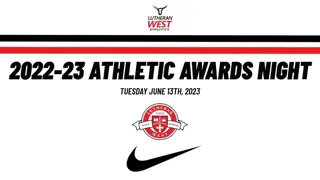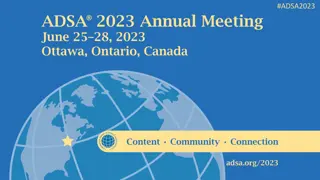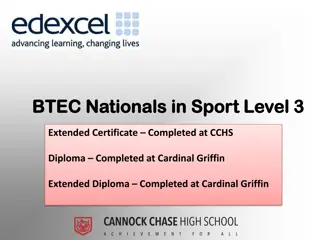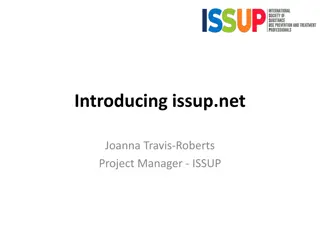
Overcoming Implementation Challenges in Early Warning Systems
Explore the challenges and opportunities in implementing Early Warning Systems (EWS) to improve graduation rates in schools. Understand the importance of EWS, learn about the national graduation rate challenge, and identify steps to enhance EWS in your educational setting.
Download Presentation

Please find below an Image/Link to download the presentation.
The content on the website is provided AS IS for your information and personal use only. It may not be sold, licensed, or shared on other websites without obtaining consent from the author. If you encounter any issues during the download, it is possible that the publisher has removed the file from their server.
You are allowed to download the files provided on this website for personal or commercial use, subject to the condition that they are used lawfully. All files are the property of their respective owners.
The content on the website is provided AS IS for your information and personal use only. It may not be sold, licensed, or shared on other websites without obtaining consent from the author.
E N D
Presentation Transcript
Overcoming Implementation Challenges to Early Warning Systems and Seizing Opportunities Baltimore, MD November 13, 2014 Joanna Hornig Fox Natalie Griffin
Session Objectives Why: Understand the need for EWS What: Learn more about what an EWS is How: Understand some of the challenges and opportunities implicit in an EWS Next: Identify a few steps that can be taken in your school or district to start or improve an EWS
The National Graduation Rate Challenge and Opportunities Challenge: Approximately 20 percent of America s students drop out of high school and do not receive a standard diploma in four years Opportunity: There has been general improvement in the last decade, of about 10 percent nationally, to an 80-81 percent average Opportunity: Gains have been driven by a 15- percentage point increase for Hispanic students and a 9-percentage point increase for African- American students Challenge: Averages mask differences among sub-groups at the state level, and within districts and schools. These can be up to and over 20 percentage points.
Getting Started Do you know the college-going and success rate in your district? From each of the high schools? Do you know the 4-year cohort graduation rate for your district? And each high school? Are there differences among subgroups? (low- income, special education, ELLs/LEPs, Hispanic, African-American, White and Asian). What do you know about feeder patterns from middle to high school? What do they tell you?
Indicators or influencers? Poor Attendance Overage: 1 2 years, 2 years+ Behavior Marks Minor Referrals Suspensions Special Education, ELL/LEP Standardized Test Scores, GPA Gender Course Failure Core Courses Elective Courses Socio-economic Status Parental Education 6
Questions What do you suspect are the main contributors to students struggles? To students strengths?
Key EWS Indicators From Longitudinal Research Behavior Attendance Course Passing Be Promoted
Four Year Graduation Rates by Freshman Absence Rates, from Chicago (CCSR) 9
Chronic Absence By Grade Level in Oregon 23% of K-12 students in Oregon were chronically absent in 2009- 10 Source: ECONorthwest analysis of ODE data, 2009-10.
Graduation Rate by GPA, from Chicago (CCSR)
Research Takeaways Good News: Students are resilient and usually signal well before dropping out Students start with one indicator and develop more indicators over time, 6th grade on We have to mix prevention with intervention, especially in 6th 9th grade Some students will move up with their classmates even if they have an indicator
Fundamental Question What do we need to do differently in middle schools to better prepare students for success in high school, college and careers?
What Do We Know About Students? Pre-K and Elementary Grades-Core academic competencies and socialized into the norms of schooling in a joyful manner Middle Grades-Intermediate academic skills (reading comprehension and fluency, transition from arithmetic to mathematics) and a need for adventure and camaraderie; extra help and support for students in need High School-Transition to adult behaviors and mind set and the right extra help for students with below grade level skills
Our choice: Can we or cant we change outcomes if students slide off-track?
What is an EWS? EWS are systems that result from collaboration among educators, administrators, parents and communities to use data effectively to keep students on the pathway to graduation. The best EWS enable: rapid identification of students who are in trouble rapid interventions that are targeted to students needs, both immediate and long-term, for support, redirection and greater success frequent monitoring of the success of interventions rapid modification of interventions that are not working shared learning with continuous improvement
Whats a Good Start? An EWS team organized around keeping students on-track: organizing data, developing student support lists, organizing adults, and applying interventions Improving interventions Developing new ones
Support List and Next Steps Support List All students with an EWS risk factor Students needing tutoring/ mentoring Students referred to outside agencies Students receiving ELA/Math intervention class Students supported by other school partners Students seeing the counselor/ social worker Students in in- and out-of school programming or clubs
Challenges and Opportunities
Challenges Large numbers of students with indicators overwhelm resources Large numbers of students increase the challenge for teachers and other school adults Differentiation within classrooms becomes more difficult
Data Is attendance data entered frequently and consistently by the data entry person in the front office? By each teacher? By each person responsible for discipline/behavior reporting? By others? Does the data system enable adults to view the ABCs for all students in a class? A grade? All students in a school? Longitudinally? Can student support lists be produced easily (eg identify at-risk students based on indicators, not demographics)? Are there agreed-on criteria for who is at risk ? Are reports relating to ABC patterns (students, subgroups, groups) available frequently? (weekly, bi-weekly, monthly?) Who has responsibility for analyzing these reports?
Data Use Is the data accurate, complete and consistent (for instance, is there a school-wide grading policy that holds teachers accountable for giving so-many gradable items per week? Is there consistency in the type of items that are graded? Are teachers entering grades at the same intervals? Etc.) Is there a team structure that enables groups of adults to consider student data together? Is there a set meeting time for the team (bi-weekly, one hour minimum) that is built into the schedule? Are there protocols for data conversations? Does school administration value the team meeting, and set expectations and hold team members accountable for participating? Do administrators participate?
EWS Team Meetings Does an interdisciplinary team of the right people meet to coordinate, create, and monitor support/interventions for students who are exhibiting early warning indicators?
EWS Discussion Protocol Identify Student (1 minute) Identifies which off-track behaviors the student is exhibiting Identifies data supporting identification for intervention (from EWS report) Team provides information (2 minutes) Team members succinctly (monitor your airtime) provide additional information about why off-track indicators may be present Team members discuss intervention options (3 minutes) Consult resource map Discuss who will champion follow up Determine date for follow-up conversation Determine communication with family
EWS Discussion Protocol Follow-Up Meetings For students who are currently receiving interventions: Team Members discuss Student Progress (2 minutes per student) 1. Identify the student support 2. Are the interventions/support working to improve student s behavior, course performance, and/or attendance? 3. How do we know (student data)? 4. What next?
Student Support Systems -- Interventions Has the team defined what an intervention is? Have you asked, What will we accomplish with this intervention? Or, Who will carry this intervention out Or, Which students are we not reaching? Or, Are there students in this school who do not have a relationship with an adult? With a peer? Or, Do we recognize students for improvement as well as achievement? Or, How can we encourage more improvement?
Student Support Systems/ Interventions Have available interventions been inventoried? Does the term intervention bring to mind only negative connotations or does it include comprehensive, school wide efforts to build student motivation and enthusiasm? Are interventions categorized by level? (how many students, how serious are the challenges, how big are the opportunities, and how many adults are needed for success, for instance?)
Possible Snags Policy and Practices Do policies and practices support promotion and graduation, specifically supporting students in staying in school, motivating students to learn and engaging them in learning at high levels? Do policies and practices support efforts to overcome difficult-to-change adult as well as student attitudes?
Possible Snags Communicating Across Transitions Do middle grades personnel many or all of them, beyond the counselors communicate with high schools to understand that and how academic and behavioral expectations differ between grades 8 and 9? Are students frequently exposed to the differing expectations before they run into them head on in grade 9? Are they prepared?
Adult Attitudes Hard Questions What is the appropriate balance between expectations and support? What do each of those words mean in the context of your school? Do adults in your school show through their actions that it is part of their professional role to support students and not simply evaluate them non- academically as well as academically?
More Hard Questions What are the top problems? What are the challenges which are under the power of adults to influence? What are the challenges that are beyond the power of adults to change? How will we prioritize? What are the opportunities? What might be three fruitful first steps?
Broadening the Circle of Support Are you drawing in school adults who represent many different perspectives on students (academic and elective teachers, counselors, school nurse, social workers, cafeteria workers, building engineers, school resource officers, etc.) Are you drawing in older students as mentors and tutors? As examples? From the high school? From local colleges? Are you drawing in community adults?
Broadening the Circle of Support Are you capitalizing on youth-engaged community resources? (retired teachers, alumni, librarians, folks who work at youth-serving community and health agencies, local judges and law enforcement representatives, for example) Are you capitalizing on business and higher- education related resources in or near your community? (the admissions and outreach folks at the community college, the chamber of commerce, the local economic development agency, etc.)
Invite the Community in Attendance, behavior and course passing improves and promotion and graduation rates rise
Almost a Last Word on EWS Find out what works for your school! The fewer indicators the better aim for a simple, clean system Most students in need of interventions can be identified by the ABC s. At the individual level, pay more attention to GPAs than state assessments. Influencers beyond the ABCs are often useful in determining type of interventions
What Works Link the EWS system to overall school improvement, achievement improvement and curriculum, instruction and assessment efforts Prioritize Tie the EWS plan into the school improvement plan/strategic plan Bring the community in Envision the future and commit to achieving it!
Contact Information Joanna Hornig Fox Deputy Director Everyone Graduates Center Johns Hopkins University jhfox@jhu.edu (410) 516-4338 Natalie Griffin Promotion Coach, C.F. Vigor High School Mobile County Public Schools, AL natalgrif@Comcast.net 251-221-3045 251-591-6248






















